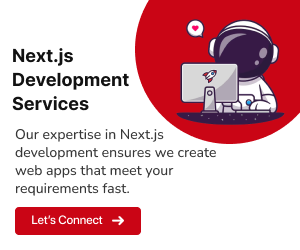Cross-Platform Clash: A Comparative Analysis of Flutter vs React Native
In the ever-evolving realm of mobile app development, the choice of the right cross-platform framework can be a pivotal decision. Developers and businesses across the United States find themselves at the crossroads of two exceptional options: Flutter and React Native. In this blog, we embark on a journey of exploration, pitting these two giants against each other in a battle of wits, capabilities, and versatility. Join us as we delve deep into the heart of this comparative analysis, where we dissect the strengths, weaknesses, and potential of Flutter and React Native, helping you make the informed choice for your next cross-platform app development project. It’s time to unravel the mystery of Flutter vs React Native and find the perfect fit for your app development needs.
Cross-Platform App Development: Bridging the Gap
In the ever-evolving landscape of mobile app development, one crucial question often arises: How can we efficiently reach both Android and iOS users without doubling our development efforts? The answer lies in cross-platform app development, a transformative approach that’s gaining prominence in the tech world.
Understanding Cross-Platform App Development:
Cross-platform app development refers to the practice of creating mobile applications that can run on multiple operating systems, such as Android and iOS, using a single codebase. Instead of building separate apps for each platform, developers write code once and deploy it across various devices. This approach aims to bridge the gap between different platforms and streamline the development process.
The Significance of Cross-Platform Development:
Cost-Efficiency:
Developing separate apps for Android and iOS can be expensive and time-consuming. Cross-platform development significantly reduces costs by allowing developers to work on a single codebase.
Faster Time-to-Market:
In the competitive app market, speed matters. Cross-platform frameworks offer features like hot reload, enabling developers to see real-time changes instantly. This accelerates the development cycle, allowing apps to reach users faster.
Consistent User Experience:
Cross-platform apps aim to provide a consistent user experience across devices and platforms. This uniformity in design and functionality enhances user satisfaction.
Broader User Reach:
By targeting multiple platforms with a single app, businesses can expand their user base. This is especially beneficial for startups and enterprises seeking to reach a wider audience.
Simplified Maintenance:
Maintaining a single codebase is more straightforward than managing separate ones. Updates and bug fixes can be applied uniformly, reducing the risk of inconsistencies.
Cross-Platform Development Approaches:
There are two primary approaches to cross-platform app development:
Hybrid App Development:
This approach uses web technologies (HTML, CSS, JavaScript) to create mobile apps that run in a native web container. Tools like Apache Cordova and Ionic are commonly used for hybrid app development.
Native Cross-Platform Development:
This approach involves using frameworks like Flutter and React Native, which allow developers to write code in a single language (Dart or JavaScript, respectively) that compiles to native code for different platforms.
In this comparison between Flutter and React Native, we’ll delve deeper into the native cross-platform development approach, exploring how each framework addresses the challenges and opportunities in this dynamic field. So, let’s journey into the world of cross-platform development to discover which framework suits your next project: Flutter or React Native.
Ready to explore Flutter’s potential for your mobile app development project in the USA? Dive into our blog: Choosing Flutter for Your USA-Based Mobile App Development Project
Exploring Flutter: A Comprehensive Introduction
Flutter, an open-source UI framework developed by Google, has taken the world of mobile app development by storm. Its inception can be traced back to May 2017 when it was first introduced at the Google I/O developer conference. Since then, Flutter has evolved into a powerful and versatile toolkit for building natively compiled applications for mobile, web, and desktop from a single codebase.
Key Features of Flutter:
Hot Reload:
One of Flutter’s standout features is “hot reload,” which allows developers to see the immediate results of code changes in real-time. This significantly speeds up the development process.
Rich Widget Library:
Flutter offers an extensive library of pre-designed, customizable widgets that simplify the creation of stunning user interfaces. From buttons to complex navigation systems, Flutter provides the building blocks for crafting pixel-perfect designs.
Cross-Platform Compatibility:
Flutter’s ability to facilitate cross-platform app development is a game-changer. Developers can use a single codebase to create applications that run seamlessly on both Android and iOS devices.
Native Performance:
Flutter apps deliver native-like performance, even for complex and graphics-intensive applications. They leverage the Skia graphics engine to render visuals, resulting in smooth animations and fluid interactions.
Strong Community:
Flutter enjoys a rapidly growing community of developers and enthusiasts. This translates to a wealth of open-source packages, libraries, and plugins that can be readily integrated into projects. The community’s collaborative spirit ensures that solutions to common challenges are readily available.
Pros and Cons of Flutter:
When evaluating Flutter for your app development project, it’s crucial to consider both its strengths and limitations. Here’s a detailed look at the pros and cons:
Pros:
Cross-Platform Compatibility:
Flutter allows you to build apps for both Android and iOS using a single codebase. This not only saves development time but also ensures consistency across platforms.
Hot Reload:
The “hot reload” feature enables real-time code changes, making development faster and more efficient. Developers can instantly see the effects of their code modifications.
Beautiful User Interfaces:
Flutter’s rich set of customizable widgets empowers developers to create stunning, pixel-perfect UIs that enhance the user experience.
High Performance:
Despite its cross-platform nature, Flutter apps boast native-like performance, even for complex and graphics-intensive applications.
Strong Community:
Flutter’s growing community means access to a wealth of open-source resources, expediting development and troubleshooting.
Cost-Efficiency:
Building a single codebase for multiple platforms reduces development costs, making it an attractive choice for startups and SMEs.
Consistency:
Flutter offers consistency in UI and behavior across different devices and platforms, ensuring a unified user experience.
Fast Development:
With Flutter, developers can create apps quickly, thanks to its extensive widget library and fast development cycle.
Integration-Friendly:
Flutter seamlessly integrates with existing native code, making it a viable choice for projects that require native modules.
Excellent Documentation:
Flutter boasts well-documented resources, making it easy for developers to get started and find solutions to common challenges.
Cons:
Large App Size:
Flutter apps tend to have a larger file size compared to native apps, which can be a concern for users with limited device storage.
Limited Access to Native Features:
While Flutter provides access to native features, some platform-specific functionalities might require additional plugins or custom development.
Learning Curve:
Developers familiar with native development might face a learning curve when transitioning to Flutter, particularly when dealing with platform-specific issues.
Smaller Community:
While the Flutter community is growing, it’s still smaller than communities for more established frameworks, which can affect the availability of specialized resources.
Third-Party Dependencies:
Relying on third-party packages for specific features can introduce risks, as package maintenance and compatibility can vary.
App Store Size Limitations:
Both the Google Play Store and Apple App Store have size limitations for apps. Flutter apps that exceed these limits may face challenges during distribution.
Platform Differences:
Flutter’s goal is to offer platform-agnostic development, but subtle differences between Android and iOS may require platform-specific adjustments.
In this section, we’ve provided a comprehensive overview of Flutter, its key features, and a detailed analysis of its pros and cons. This knowledge will serve as a solid foundation as you explore Flutter for your upcoming app development endeavors.
Exploring React Native: A Comprehensive Introduction
React Native, developed by Facebook, is a widely-used open-source framework for building mobile applications. It was first released in 2015 and has gained popularity for its ability to create cross-platform apps using JavaScript and React, a popular web library. React Native allows developers to use a single codebase to target both iOS and Android platforms.
Key Features of React Native:
Reusability of Code:
React Native enables code reusability across platforms, saving development time and resources.
Native Components:
Developers can use native components along with React Native components, providing access to the full range of native device features.
Hot Reload:
Similar to Flutter, React Native offers a “hot reload” feature for real-time code updates, enhancing the development experience.
Large Community:
React Native benefits from a large and active community, leading to extensive support, third-party libraries, and plugins.
JavaScript:
Developers can leverage their existing JavaScript skills, making it accessible to a broad range of web developers.
Pros and Cons of React Native:
Now, let’s dive into the advantages and disadvantages of using React Native for app development:
Pros:
Code Reusability:
React Native promotes code reusability, allowing developers to write a single codebase for both iOS and Android.
Native Components:
Access to native components ensures that React Native apps can offer a native-like user experience.
Hot Reload:
The “hot reload” feature accelerates development by providing instant feedback on code changes.
Large Community:
React Native’s extensive community support means a wealth of resources and solutions are readily available.
JavaScript:
Developers can utilize their JavaScript skills, making it a practical choice for web developers transitioning to mobile app development.
Cons:
Performance:
While React Native offers good performance, complex and resource-intensive apps may require additional optimization.
Native Modules:
Access to certain native modules might require custom development or third-party libraries.
Bridge Overhead:
Communication between JavaScript and native modules can introduce some bridge overhead, affecting performance in certain scenarios.
Learning Curve:
Developers new to React Native might face a learning curve, especially when dealing with native module integration.
This section provides an in-depth overview of React Native, its key features, and a detailed analysis of its pros and cons. Understanding these aspects will help you make an informed decision when considering React Native for your mobile app development projects.
Exploring Excellence in Mobile App Development: Meet the Top 10 Flutter Developers in New York
Performance Comparison:
When choosing a framework for your mobile app development project, performance is a critical factor to consider. Let’s compare the performance of Flutter and React Native across several key aspects:
Speed:
Flutter, known for its use of the Skia graphics engine, excels in delivering high-speed performance. It achieves near-native speeds by rendering visuals efficiently. React Native also provides good performance but may require additional optimization for resource-intensive tasks.
Animations:
Both Flutter and React Native offer support for animations, but Flutter’s built-in animation library makes it easier to create smooth and complex animations. React Native relies on third-party libraries for animations, which can vary in performance and compatibility.
Resource Consumption:
Flutter apps tend to have a larger initial file size due to including its framework. However, it can lead to more optimized performance during runtime. React Native apps have a smaller initial size but might require additional resources at runtime due to bridge communication between JavaScript and native modules.
UI Responsiveness:
Flutter’s architecture allows for consistent UI responsiveness, even in complex apps. React Native’s performance can vary based on how well third-party modules are optimized for your specific use case.
Development Speed:
Flutter’s “hot reload” feature enhances development speed by providing real-time feedback on code changes. React Native also offers a hot reload feature, but the speed and efficiency of development can depend on the complexity of your app and third-party library integrations.
Native Modules:
When it comes to integrating native modules, React Native offers an advantage as it directly interfaces with native code. This can lead to better performance in scenarios requiring extensive native module usage.
Community and Optimization:
Both frameworks have active communities, but Flutter’s rapid growth means it may take some time for all third-party packages to be fully optimized. React Native, being older, has a more mature ecosystem in terms of third-party packages and optimizations.
In summary, Flutter generally offers excellent performance across various aspects, especially in terms of speed, animations, and UI responsiveness. React Native also provides good performance but may require careful optimization, depending on your project’s specific requirements and third-party dependencies.
When to Use Flutter vs. React Native:
Choosing between Flutter and React Native depends on your specific project requirements and goals. Let’s explore scenarios where each framework shines:
Use Flutter When:
Cross-Platform Development is Crucial:
If you need to develop apps for both Android and iOS with a single codebase to save time and resources, Flutter’s cross-platform capabilities make it an ideal choice.
Pixel-Perfect UI is a Priority:
When creating visually captivating and highly customized user interfaces is essential for your app, Flutter’s rich widget library and design flexibility can help you achieve pixel-perfect designs.
Performance is a Priority:
If your app requires native-like performance, even for complex and graphics-intensive applications, Flutter’s use of the Skia graphics engine ensures smooth animations and fluid interactions.
You Prefer Rapid Development:
Flutter’s “hot reload” feature speeds up development by providing real-time feedback on code changes, making it a top choice for projects with tight deadlines.
Integration with Native Code is Essential:
When you need to integrate native modules extensively into your app, Flutter’s seamless integration with native code can be advantageous.
Cost-Efficiency is a Priority:
If you’re a startup or small to medium-sized enterprise (SME) looking to optimize your development budget, Flutter’s single codebase for multiple platforms can reduce costs.
Strong Community Support Matters:
Flutter’s rapidly growing community ensures access to a wealth of open-source resources, making development more efficient.
Documentation is Vital:
If you prefer well-documented resources and easy access to solutions for common challenges, Flutter’s documentation can be a valuable asset.
Use React Native When:
Existing JavaScript Knowledge:
If your development team is already proficient in JavaScript, React Native provides an advantage with its JavaScript-based development approach.
Access to Native Modules is Critical:
When your project relies heavily on native modules or requires deep integration with native code, React Native’s direct interface with native components can be beneficial.
Mature Ecosystem and Stability:
For projects that require a mature ecosystem of third-party packages and libraries, React Native’s longer presence in the market offers stability and a wide range of resources.
Small to Medium-Sized Apps:
If you’re developing smaller to medium-sized applications with limited complexity, React Native can be a pragmatic choice, especially for quicker development.
Immediate Market Entry:
When you need to enter the market quickly and the initial app size is a concern, React Native’s smaller initial footprint can be advantageous.
React Web Integration:
If you plan to build web applications alongside mobile apps using the same codebase, React Native’s compatibility with React for web can simplify development.
Community Size and Maturity:
React Native’s mature community ensures access to a variety of resources and experienced developers.
Platform-Specific Development:
For projects where platform-specific development and optimizations are required, React Native flexibility allows for tailored solutions.
Ultimately, the choice between Flutter and React Native depends on your project’s unique requirements, your team’s
Mastering the Art of Building a Flutter App Development Team in the USA: Building a Cost-Effective flutter app Development Team -US guide
Closing Thoughts: Making the Right Choice for Your Cross-Platform Project
In the grand arena of cross-platform app development, React Native and Flutter stand as two formidable contenders, each with its own set of strengths and quirks. As we conclude this exploration of ‘React Native Vs Flutter: Which Cross-Platform Framework Should You Choose for Your Next Project?’ one thing becomes clear: there is no one-size-fits-all answer. The choice between React Native and Flutter ultimately hinges on your specific project requirements, team expertise, and long-term vision. Both frameworks offer exciting opportunities, and the decision should be guided by a deep understanding of your project’s unique needs. Embrace the power of informed decision-making, and may your chosen framework pave the way for exceptional app development in the dynamic landscape of the USA.



















